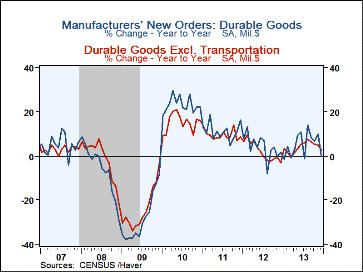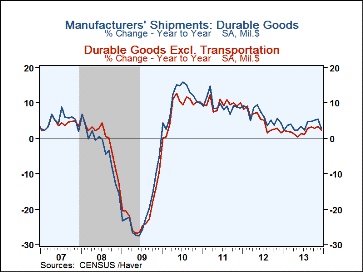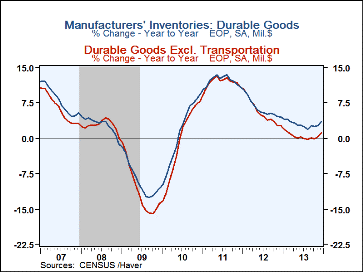 Global| Jan 28 2014
Global| Jan 28 2014U.S. Durable Goods Orders Lose Forward Momentum
by:Tom Moeller
|in:Economy in Brief
Summary
The durable goods manufacturing sector had a good year in 2013. New orders increased 5.1% for the full year following a 4.1% gain in 2012. These increases were, however, slower than the double-digit gains of the prior two years. [...]
The durable goods manufacturing sector had a good year in 2013. New orders increased 5.1% for the full year following a 4.1% gain in 2012. These increases were, however, slower than the double-digit gains of the prior two years. Earlier strength in the durable manufacturing sector eased at yearend. Orders for durable goods declined 4.3% (+0.1% y/y) last month following a 2.6% November jump, revised from the initial report of a 3.5% increase. A 1.7% rise had been expected in the Action Economics Forecast Survey. A 17.5% drop (+26.3% y/y) in orders for nondefense aircraft & parts led the outsized decline in bookings last month. In addition, defense aircraft orders were off 12.9% (-51.2% y/y. Weakness in the transportation sector also reflected a 5.8% drop (+7.4% y/y) in motor vehicles & parts orders.
Outside of the transportation sector new orders fell 1.6% (+2.9% y/y) following three months of modest gain. Orders for electrical equipment, appliances & components increased 2.8% (3.7% y/y) and orders for machinery gained 0.8% (14.8% y/y). These increases were offset, however, by a 7.8% slide (-4.3% y/y) in orders for computers & electronic products. Earlier strength in business investment also eased last month. Nondefense capital goods orders fell 5.0% (+11.3% y/y) as orders excluding aircraft declined 1.3% (+6.2% y/y).
Shipments of durable goods declined 1.9% (+2.8% y/y) in December following four consecutive months of increase. Shipments excluding the transportation sector slipped 0.3% (+2.4% y/y), also after four months of gain. Unfilled orders gained 0.4% (7.0% y/y) but order backlogs outside of the transportation sector slipped 0.2% (+6.4% y/y). Inventories of durable goods jumped 0.8% (3.6% y/y), the largest increase since September. Inventories outside the transportation sector rose 0.7% (1.2% y/y).
The Productivity Paradox: Is Technology Failing or Fueling Growth? from the Federal Reserve Bank of Atlanta is available here.
The durable goods figures are available in Haver's USECON database. The Action Economics consensus forecast figure is in the AS1REPNA database.
| Durable Goods NAICS Classification | Dec | Nov | Oct | Y/Y | 2013 | 2012 | 2011 |
|---|---|---|---|---|---|---|---|
| New Orders | -4.3 | 2.6 | -0.7 | 0.1 | 5.1 | 4.1 | 11.0 |
| Transportation | -9.5 | 7.9 | -3.5 | -5.4 | 7.9 | 8.9 | 14.9 |
| Total Excluding Transportation | -1.6 | 0.1 | 0.7 | 2.9 | 3.9 | 2.1 | 9.5 |
| Nondefense Capital Goods | -5.0 | 7.8 | -0.8 | 11.3 | 8.7 | 3.7 | 15.3 |
| Excluding Aircraft | -1.3 | 2.6 | -0.6 | 6.2 | 5.1 | 2.1 | 11.6 |
| Shipments | -1.9 | 1.3 | 0.6 | 2.8 | 3.7 | 6.4 | 9.4 |
| Inventories | 0.8 | 0.3 | 0.3 | 3.6 | 3.6 | 4.5 | 10.8 |
| Unfilled Orders | 0.4 | 0.9 | 0.6 | 7.0 | 7.0 | 3.7 | 10.0 |
Tom Moeller
AuthorMore in Author Profile »Prior to joining Haver Analytics in 2000, Mr. Moeller worked as the Economist at Chancellor Capital Management from 1985 to 1999. There, he developed comprehensive economic forecasts and interpreted economic data for equity and fixed income portfolio managers. Also at Chancellor, Mr. Moeller worked as an equity analyst and was responsible for researching and rating companies in the economically sensitive automobile and housing industries for investment in Chancellor’s equity portfolio. Prior to joining Chancellor, Mr. Moeller was an Economist at Citibank from 1979 to 1984. He also analyzed pricing behavior in the metals industry for the Council on Wage and Price Stability in Washington, D.C. In 1999, Mr. Moeller received the award for most accurate forecast from the Forecasters' Club of New York. From 1990 to 1992 he was President of the New York Association for Business Economists. Mr. Moeller earned an M.B.A. in Finance from Fordham University, where he graduated in 1987. He holds a Bachelor of Arts in Economics from George Washington University.










